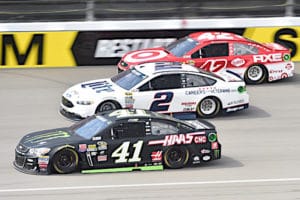Brad Keselowski had a rough night at Kentucky Speedway. The No. 2 team, understandably, went to the Bluegrass State with high expectations, having won three of the six Cup Series events held at the 1.5-mile track. While Keselowski ran just outside the top 10 through much of the first stage, he clearly did not have the speed he had flashed at Kentucky in prior starts.
To make matters worse, Keselowski got tangled up in a crash with Jimmie Johnson and Clint Bowyer right after the second stage began. The resulting damage to the No. 2 car forced Keselowski to retire from the race, finishing 39th.
Once out, Keselowski made some comments on Sirius/XM’s NASCAR Radio that will probably be remembered longer than anything that happened in the race.
“I am probably as much frustrated with myself as I am frustrated with the situation,” Keselowski said, “and frustrated with the sport that we can’t design a better car than this that you can race without having to do everything on the restart.”
“It is a poorly designed car and it makes racing on tracks like this very difficult to put on the show that we want to put on for our fans,” Keselowski added. “You do what you can to gouge and claw on the restarts and get everything you can. You have to put yourself in bad situations to do that and that is where we were.”
Keselowski finished his statement by calling on NASCAR “to design a new car that is worthy of where this sport deserves to be and the show it deserves to put on for its fans.”
The disappointment of the crash no doubt fueled the anger of Keselowski’s comments. He also released the following statement later.
I lost "Truth and Grace" after wrecking out today so I wrote a Follow up on my post wreck comments- pic.twitter.com/LmORJArdjp
— Brad Keselowski (@keselowski) July 9, 2017
The context within which Keselowski criticized the Gen-6 car, as well as his second statement, might cause fans to take his comments with a grain of salt. However, Keselowski is right, and NASCAR should pay attention.
The worst thing that NASCAR could do is to trot out the old “actions detrimental to stock car racing” excuse and saddle Keselowski with a fine. Tony Stewart met the same fate last year after criticizing NASCAR’s apparent lack of concern for safety when enforcing its lug nut rules. An even better example is Denny Hamlin in 2013, who made similar comments about the Gen-6 car following a race at Phoenix International Raceway. That particular event was only the second time that NASCAR used the new car, and learning its ins and outs remained an ongoing process. Yet, the Gen-6 car being new does not excuse NASCAR’s over-sensitivity in punishing Hamlin.
In fact, Keselowski likely released the second statement in an attempt to avoid any repercussions from NASCAR. Nothing about the 2012 series champion’s first round of comments suggests that he is dissatisfied with being a NASCAR driver in the first place. His primary dissatisfaction is with the car.
Though Keselowski also hinted at dissatisfaction with something else, how drivers have to race following restarts. Admittedly, this is nothing new. NASCAR implemented its current double-file restart format in 2009. The move was designed to create better competition for the fans, and it had the blessing of the drivers. Being able to get good restarts has taken on greater importance than it had before. Yet at tracks like Kentucky, that importance rises to an even higher level.
On Saturday night, it was common to see the field get strung out after a handful of laps. Despite NASCAR’s efforts to take away downforce and put more driving capability in the drivers’ hands, passing was still difficult. Restarts, however, have the potential for many positions to be gained or lost. So, for a lap or two after each green flag waves, drivers have to take extra chances to establish better track position. Throw in the advent of stage racing, and drivers know that there will be at least two restarts per race.

Keselowski’s comments suggest a growing disconnect between NASCAR and its drivers. NASCAR likes to sell its restarts as must-see moments of the race. Many times, they are. Drivers like Kyle Busch and Kyle Larson have made picking up positions after restarts an art form. Seeing drivers push themselves and their cars to the brink is a great thrill for fans.
On the other hand, it is obvious why the drivers might not like this arrangement. If, at Kentucky for instance, passing becomes difficult three or four laps after a restart, drivers have a very limited window to make decisive moves. The choices become to either make a risky move to pass the cars in front of you, or to back off, potentially lose positions, and spend the next green flag run trying to make up those positions. That is a tight box for a driver to be in, especially during a three to four-hour race.
If NASCAR designed a car that allowed drivers to make more passes over long runs, we would see driver ability matter more over the course of a whole race. It would be a better situation for the drivers themselves, who would not have to scramble so much each time the race resumes. Restarts would lose some of their current, thrill-inducing potential, but that seems like a small price to pay for a car that could produce a better overall race.
Bryan began writing for Frontstretch in 2016. He has penned Up to Speed for the past eight years. A lifelong student of auto racing, Bryan is a published author and automotive historian. He is a native of Columbus, Ohio and currently resides in Southern Kentucky.



